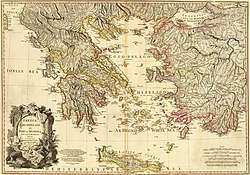| History of Greece |
|---|
 |
This is a chronology of ancient Greek mathematicians .
| c. 624 BC – c.546 BC | – Thales |
| c. 586/585 – c. 526/525 BC | - Anaximenes |
| c. 570 BC – c. 495 BC | – Pythagoras |
| c. 530 BC - C. 450 BC | – Hippasus |
| c. 490 BC – c. 420 BC | – Oenopides |
| 480 BC – 411 BC | – Antiphon |
| c. 470 BC – 410 BC | – Hippocrates |
| 465 BC – 398 BC | – Theodorus |
| c. 460 BC – c. 370 BC | – Democritus |
| c.428/427 BC – c. 348/347 BC | – Plato |
| c.428 BC – c. 347 BC | – Archytas |
| c. 417 BC – 369 BC | – Theaetetus |
| 408 BC – 355 BC | – Eudoxus |
| c. 400 BC – c. 350 BC | – Thymaridas |
| c. 400 BC – 335 BC | – Hicetas |
| c. 390 BC − c. 320 BC | – Dinostratus |
| 384 BC – 322 BC | – Aristotle |
| 380 BC − 320 BC | – Menaechmus |
| c. 370 BC – c. 300 BC | – Aristaeus |
| c. 370 BC – c. 300 BC | – Callippus |
| c. 360 BC – c. 290 BC | – Autopicus |
| c. 340 BC – c. 285 BC | – Polyaenus |
| fl. 320 BC – fl. 280 BC | – Euclid |
| fl. 310 BC – fl. 230 BC | – Aristarchus |
| c. 287 BC – c. 212 BC | – Archimedes |
| c. 280 BC – c. 220 BC | – Conon |
| c. 276 BC – c. 194 BC | – Eratosthenes |
| c. 262 BC – c. 190 BC | – Apollonius |
| c. 190 BC – c. 120 BC | – Hipparchus |
| c. 160 BC – c. 100 BC | – Theodosius |
| fl. c. 150 BC | – Perseus |
| c. 135 BC – c. 51 BC | – Posidonius |
| fl. 1st century BC | – Geminus |
| c. 10 – c. 70 | – Hero |
| c. 60 – c. 120 | – Nicomachus |
| c. 70 – c. 135 | – Theon |
| c. 70 – c. 140 | – Menelaus |
| c. 100 – c. 170 | – Ptolemy |
| c. 200/214 – c. 284/298 | – Diophantus |
| c. 240 – c. 300 | – Sporus |
| c. 290 – c. 350 | – Pappus |
| c. 300 – c. 360 | – Serenus |
| c. 335 – c. 405 | – Theon |
| c. 350 – 415 | – Hypatia |
| 412 – 485 | – Proclus |
| c. 420 – c. 480 | – Dominus |
| c. 474 – 533 | – Anthemius |
| c. 480 – c. 540 | – Eutocius |
| c. 490 – c. 560 | – Simplicius |